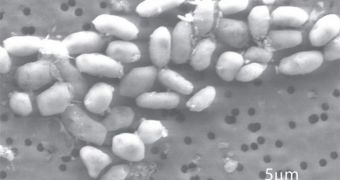On December 2, NASA experts announced the discovery of a new lifeform here on Earth, that substituted arsenic for phosphorus in its most basic processes. The remarkable finding has been heavily criticized since, and a heated debated has been raging on over this topic for about a week.
Yesterday, December 7, one of the researchers involved in the original discovery said that he stands behind his group's findings, in spite of counterarguments coming from fellow scientists.
Study coauthor Ron Oremland gave a lecture on Tuesday at the NASA Headquarters, in Washington, DC, arguing for his team's discovery, and addressing concerns expressed by other experts.
What the December 2 study – which was published in the top journal Science – says is that the bacteria GFAJ-1, recovered from the alkaline, arsenic-rich and hypersaline waters of Lake Mono, California, can incorporate arsenic into DNA.
Other molecules, such as proteins and enzymes, and also the basic energy unit of the body – adenosine triphosphate (ATP) – are also believed to endure despite the lack of critically-important phosphorus.
The main implication of the investigation is that life as we know it may need to have its underlying theories revisited. If arsenic can be used by microorganisms, then why not other elements too?
With such questions, the NASA Exobiology Program group proposed a new approach to determining which environments are suited to hold life, an issue with direct applications for exoplanetary research.
But the methods used in the investigation, as well as the conclusions, came under intense criticism from other researchers, who went as far as to argue that the study should have never gone to print.
At the meeting, Oremland argued that criticism is a natural part of the scientific method, and provided arguments to support the fact that he and his team respected procedure while conducting the study.
“Science works in a certain way. It's resistant to change. But if you look qualitatively at our data, it's compelling,” said the expert, who is based at the US Geological Survey (USGS), in Menlo Park, California.
The research effort was led by USGS-NASA astrobiology research fellow Felisa Wolfe-Simon, who collected the microbe samples from Lake Mono. This peculiar body of water developed its peculiar chemical composition after being separated from freshwater supplies for more than 50 years.
Some critics to the work say that there is insufficient evidence that GFAJ-1 actually takes arsenic up into its DNA. They add that the poisonous chemical may in fact reside outside of the DNA strands.
Others argue that the culture medium in which the bacteria were grown contained sufficiently large amounts of phosphorus – in the form of contaminants – to allow for the microorganism to survive.
“There's a class of hypotheses which, as Carl Sagan says, are exceptional and therefore require exceptional evidence. We are not expecting this result to survive,” says Steven Benner.
He holds an appointment as a biochemist at the Gainesville, Florida-based Foundation for Applied Molecular Evolution, but was not involved in the NASA-sponsored study, LiveScience reports.
In his presentation, Oremland said that his fellow scientists are right to be skeptical, and adds that some of the additional tests the critics proposed may actually prove useful. But the expert continued to defend his team's findings.
“There's dozens and dozens of things that could be done, and should be done. We can't do everything,” he said.
“I think we had enough to get the point out. Certainly the [paper's] reviewers liked it, and now the community is going to judge,” the researcher added.
“They may prove us wrong, or they may reproduce the results and find new stuff. It's the way the process works,” Oremland concluded.

 14 DAY TRIAL //
14 DAY TRIAL //